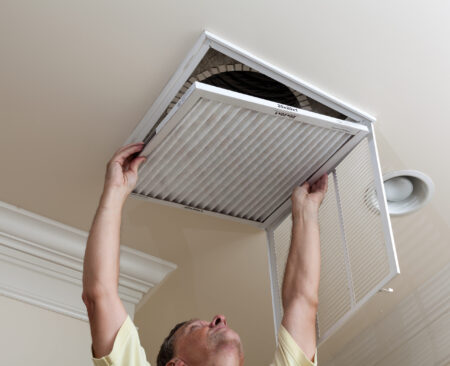August 21, 2024

MERV filters are HVAC filters, also called furnace and air conditioner filters. They serve several purposes. MERV filters keep an HVAC filter free of dust and other debris without restricting airflow too much. They also help improve indoor air quality by removing particulates from the air. Let’s explore HVAC filters and the MERV rating system in further detail.
History of MERV
The American Society of Heating, Refrigerating and Air-Conditioning Engineers (ASHRAE) is a U.S.-based but global professional association for the HVAC industry. ASHRAE developed the minimum efficiency reporting value (MERV) scale in 1987. It was not the first rating system for air filters, but the existing systems didn’t fully meet industry needs. ASHRAE wanted to provide an indicator of minimum filter performance to HVAC professionals and customers at a glance. It was so effective that the American National Standards Institute (ANSI) accredited the system. The Department of Energy (DOE) and Environmental Protection Agency (EPA) both recognize it as the standard and use it as a criterion in their studies.
MERV Rating System
ASHRAE limited the MERV scale to a range of filtration relevant to the HVAC industry. This is important because denser filter materials can cause a pressure drop. That drop can cause reduced comfort, increased energy consumption and heightened equipment wear and tear. ASHRAE also developed the system with the goal that a rating would indicate the minimal potential performance of a new filter. This performance is within the context of particles ranging from 0.3 to 10.0 micrometers.
Particulate Matter
ASHRAE developed the MERV scale to measure an air filter’s ability to trap particulate matter (PM). Large PM includes particulates that are 10.0 microns and smaller. Scientific circles abbreviate this PM10. Most air filters also trap fine PM, which are particles 2.5 microns in size and smaller. Scientific circles abbreviate this PM2.5. PM10 encompasses dust and many other household allergens that we deal with daily. PM2.5 is fine particular matter that’s particularly harmful to human health. Long-term exposure to PM2.5 may cause a range of cardiovascular and respiratory diseases. Exposure to PM10 causes respiratory inflammation but may also trigger allergies and worsen allergy symptoms. Long-term exposure may cause respiratory mortality.
The MERV Scale
Many MERV filters have a pleated design made from materials like paper, cotton and polyester. There are also mesh-style MERV filters made from materials like fiberglass. Material and design don’t necessarily indicate effectiveness. You can determine this through the MERV scale, which ranges from 1 to 16. You’ll find some resources that reference the scale as 1 to 20. Neither ASHRAE nor ANSI actually support those additional entries to the scale. That inclusion probably reflects the marketing that some brands have used to label and advertise their high-performance filters.
MERV 1-4
This range is notable in that it only traps particles of 10 microns and larger. It does that at an efficiency under 20%. Some residential AC window units use this MERV range. Most HVAC systems benefit from a higher range. Allergens trapped by a MERV 1-4 filter include:
- Pollen
- Cockroach debris
- House dust and dust mites
- Sanding and spray paint dust
- Carpet and other textile fibers
MERV 5-8
This range of MERV is generally the baseline for residential applications but also commercial and industrial uses. Effectiveness is at least 20% but is as high as 70%. MERV 8 is the recommended minimum for modern ducted and ductless HVAC systems. MERV 8 filters are the first on the scale to provide PM2.5 filtration but also filtration of particles smaller than 3.0 microns. It does this at a 20% efficiency. In addition to the particles listed above, MERV 5-8 filters trap:
- Pet dander
- Mold spores
- Dust mite debris
- Hairspray and fabric protector
MERV 9-12
This MERV range provides a minimum efficiency of 75% PM10 and 35% PM2.5. At the upper end of the range, the minimum efficiency is 90% PM10 and 80% PM2.5. The effectiveness of filtering ultrafine particles ranges from 20% at MERV 11 to 35% at MERV 12. Besides the particles listed earlier, MERV 9-12 filters will trap:
- Lead dust
- Legionella
- Humidifier dust
- Nebulizer droplets
- Auto emission particles
MERV 13-16
This range provides a minimum efficiency of 90% PM10 and 85% PM2.5. Effectiveness down to 0.3 microns is at least 50%. At the upper end of the range, efficiency increases to 95% across the board. Besides the particles listed above, MERV 13-16 filters will trap:
- Smoke
- Bacteria
- Cooking oil
- Sneeze droplets
HEPA Filtration
HEPA stands for high-efficiency particulate air. Scientists originally developed HEPA filters for laboratory use, and they’re now commonly used in hospitals and homes for air purification. You’ll sometimes see these labeled as MERV 17-20, but as mentioned, that’s not accurate. A HEPA filter, as recognized by the U.S., traps 99.97% of particles down to 0.3 microns. Down to 0.1 microns, there are degrees of difference among HEPA filters, but the U.S. standard doesn’t reflect this. Some other rating systems, such as the European standard, do.
MERV Filters for HVAC
Most modern HVAC systems support a MERV filter rated between 8 and 13. It’s a good idea to use the highest-rated filter your system supports to protect it and improve air quality. Avoid using a higher-rated MERV filter as it may increase operating costs and wear and tear. It’s uncommon for an HVAC system to support a MERV above 14, including HEPA filters.
MERV Filters for Air Purification
Whole-house air purifiers generally operate on the return side of the system. The means you can use a MERV or HEPA filter without consideration for static air pressure. It’s also worth noting that at MERV 13-16, the allergen filtration is nearly as good as with HEPA. HEPA filters will provide much better filtration of fine and ultrafine PM.
What About FPR?
Filter performance rating is an alternative to the MERV system developed by Home Depot. You’ll usually only see it on filters in those stores. Those filters will usually show the MERV rating as well. Generally, FPR 5-10 maps to MERV 8-13.
What About MPR?
The company 3M developed the microparticle performance rating to reflect performance filtering smaller particles. You’ll only see it listed on 3M-branded filters. The company also includes the MERV rating, where applicable, on all air filters it sells.
Other MERV Applications
While ASHRAE created MERV for the HVAC industry, the automotive industry has adopted it as well. The typical cabin filter is MERV 8-13 just as with home HVAC systems. The industry also uses MERV for engine air filters. Automobile engines generally need a MERV 11 filter or greater.
Need More Information About MERV Filters?
If you have further questions about MERV filters, Scott-Lee Heating Company will be glad to answer them. Our company has been serving homeowners and businesses throughout St. Louis and the surrounding areas since 1978. Our NATE-certified HVAC technicians install, maintain and service furnaces, air conditioners, heat pumps, including geothermal systems, and ductless mini-splits.
We have sheet metal fabricators and can install new ductwork or maintain and repair your existing ducts. Our indoor air quality team specializes in whole-house ventilation, air purification, humidification and dehumidification. We also specialize in HVAC zoning and air balancing. Contact us today to learn more about these products and services or to book an appointment or consultation.
